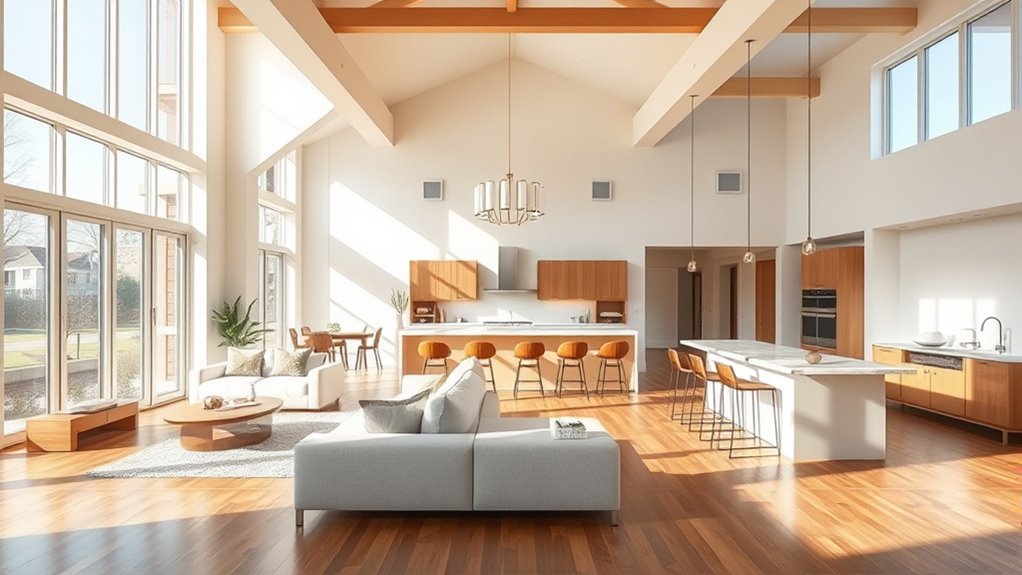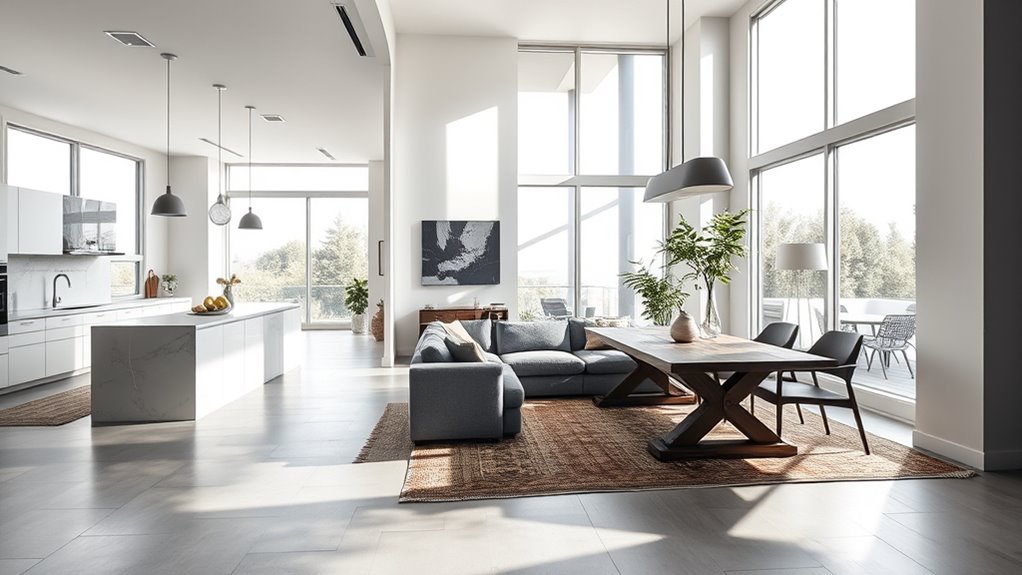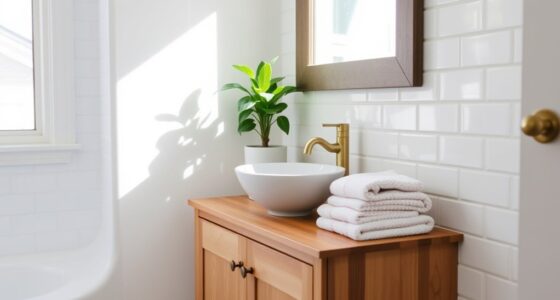Open concept living spaces create a bright, spacious environment that’s perfect for socializing and modern living. They foster connectivity and make your home feel larger, while allowing natural light to flow freely. However, they also reduce privacy and can cause noise and clutter to spread easily. Despite these challenges, with thoughtful planning, you can enjoy the benefits. Keep exploring to discover how to make open layouts work best for your needs.
Key Takeaways
- Open concept spaces create a spacious, modern feel and enhance natural light flow throughout the home.
- They promote social interaction and easy supervision, ideal for family living and entertaining.
- Lack of privacy and noise travel can cause distractions and discomfort in open layouts.
- Visual clutter and sensory overload are common challenges requiring good organization and design.
- Implementing zone-defining elements like rugs and partial dividers can balance openness with privacy needs.

Open concept living spaces have become a popular trend in modern home design, emphasizing openness and connectivity by removing walls between key areas like the kitchen, dining, and living rooms. This layout creates a sense of spaciousness that can make your home feel larger and more inviting. Without barriers, natural light flows freely across the entire area, brightening up the space and reducing the need for artificial lighting during the day. The open flow encourages easier movement, making daily activities more practical and seamless. The modern aesthetic of open spaces offers an expansive visual appeal that many find attractive, giving your home a fresh and up-to-date look. Plus, the flexibility in furniture arrangement allows you to adapt the space easily to suit different needs or occasions, whether you’re hosting guests or relaxing with family.
Open concept layouts create spacious, bright, and flexible living areas that foster social connection and modern style.
One of the biggest benefits of open concept layouts is how they enhance social interaction. With fewer walls, you can easily keep an eye on children while cooking or working, fostering better family engagement. When entertaining guests, the open space allows you to move freely, chat with everyone, and create a lively, inclusive atmosphere. This setup encourages a sense of community within your home, as everyone shares the same space without barriers. It’s also ideal for relaxed gatherings, making your home more hospitable and welcoming. In smaller homes, removing interior walls maximizes space, making rooms feel less cramped and more functional. It allows you to utilize every inch efficiently, creating a brighter, more open environment that doesn’t feel confining. The modern look helps even older or compact homes appear more stylish and up-to-date. Additionally, open concept layouts can increase the overall value of a home, as many buyers find this design appealing and modern.
Furthermore, some open concept designs incorporate features such as dedicated zones or partial dividers to help mitigate noise and privacy concerns while maintaining an open feel. However, open concept living spaces aren’t without drawbacks. The lack of walls means less privacy, which can be problematic if you want quiet time or need to hide messes. Noise travels easily across the space, making it harder to contain sounds from the kitchen, TV, or conversations. This can lead to distractions, especially if you work from home or need calm and quiet. Visual distractions are also common, as clutter and activity in one area are always visible from others, requiring better organization to maintain a tidy appearance. For those seeking intimate moments or private conversations, the open layout can feel exposed or uncomfortable. Additionally, noise and activity from different zones can create sensory overload, impacting focus and relaxation.
To address these challenges, some homeowners implement strategies like area rugs, furniture placement, or sound-absorbing materials to reduce noise and define zones. Despite these issues, many find that the benefits of spaciousness, improved social connection, and modern aesthetics outweigh the drawbacks, especially when you’re willing to adapt your space with thoughtful planning. Ultimately, open concept living offers a versatile, stylish, and practical environment—if you’re prepared to manage the noise and privacy considerations that come with it.
Frequently Asked Questions
How Does Open Concept Living Affect Home Privacy?
Open concept living impacts your privacy by removing walls that create secluded areas, making it harder to find quiet space. Noise travels easily through shared areas, and the lack of boundaries can cause clutter and stress. You may struggle to separate work from personal life, especially during busy times. To improve privacy, consider using room dividers, flexible furniture, or designated private zones within your open space.
Are Open Floor Plans Suitable for Small Homes?
Imagine your small home as a blank canvas—an open floor plan can make it feel like a spacious gallery. You’ll enjoy brighter rooms, better flow, and more flexibility in arranging furniture. While privacy might take a hit, strategic design choices like smart partitions and color schemes can define zones. Overall, open layouts suit small homes, making them feel larger, livelier, and more adaptable for everyday living and entertaining.
What Are the Best Ways to Reduce Noise in Open Spaces?
To reduce noise in open spaces, you should incorporate thick rugs to absorb sound, and arrange sectional furniture to create zones that block noise. Adding acoustic panels and diffusers on walls helps minimize echo, while plants and textured decor diffuse sound reflections naturally. Use solid-core doors and partitions where possible, seal gaps with caulk, and treat ceilings with absorptive materials to effectively lower overall noise levels.
How Does Open Concept Design Impact Home Resale Value?
You might think open concept designs always boost resale value, but that’s not always the case. While they create a spacious, modern look that many buyers love and can increase your home’s worth by up to 15%, changing trends and preferences for privacy can cut that benefit. If buyers value cozy, private spaces more, your open layout might not fetch the highest price. So, weigh current market demands carefully before deciding.
Can Open Layouts Be Customized for Different Lifestyles?
You can definitely customize open layouts for different lifestyles by using modular furniture, which is easy to rearrange. Add flexible storage like open shelving or custom cabinets, and define zones with rugs or lighting to suit your needs. Adjust seating, window treatments, and textiles to create a cozy or functional space. This way, your open layout adapts seamlessly, making it perfect for your unique lifestyle and activities.
Conclusion
Ultimately, open concept living offers a blend of brightness and buzz, boosting your home’s beauty and bonding with loved ones. But, beware of the downsides—distractions and dust can dampen your daily delight. Weigh the wins and woes carefully, and decide whether the spacious, social style suits your space and style. With thoughtful thought and a bit of planning, you can create a cozy, cohesive haven that truly feels like home.









